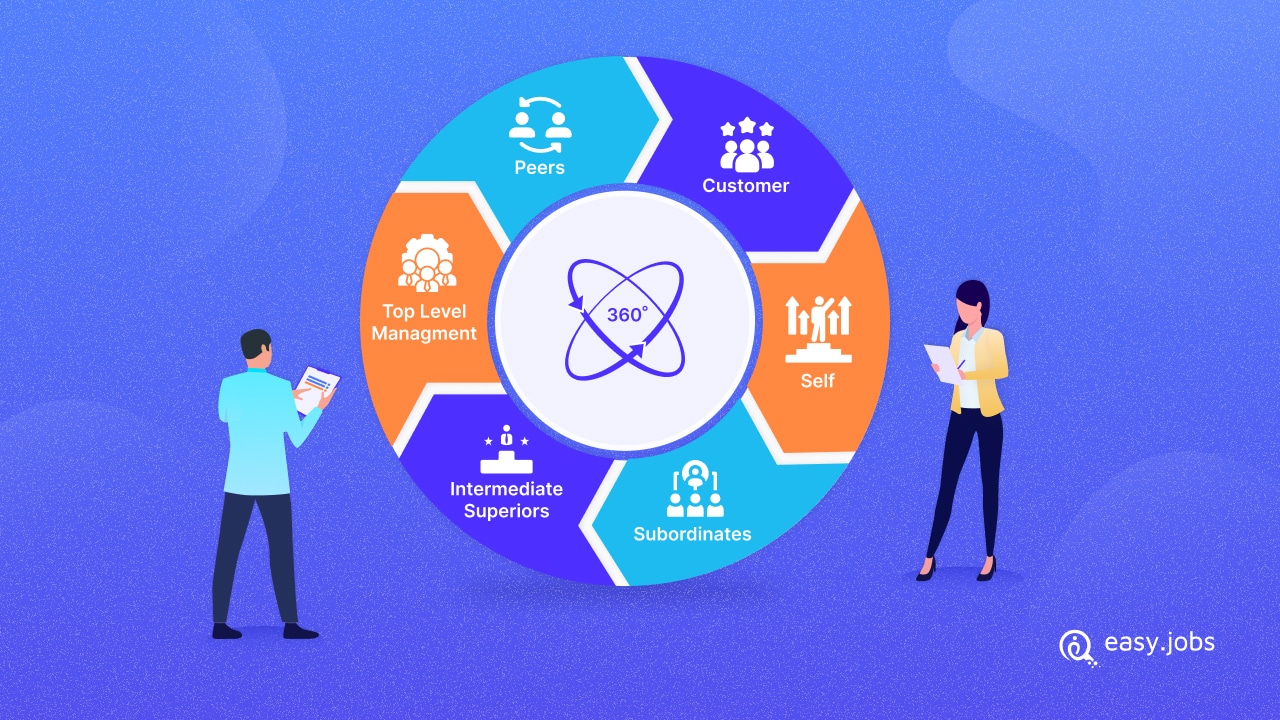To expand and improve your business growth in the modern world, you must regularly assess the performance of your team. Let us present you with the 360 degree evaluation process that allows you to thoroughly analyze your employees to identify their strengths and shortcomings and make the best use of them. As per Forbes, the 360 degree evaluation process is a crucial component of the overall leadership development strategy employed by over 85% of Fortune 500 companies.
Want to learn how to implement 360 degree evaluation? Then, this blog is for you. We will walk you through the process of successfully implementing a 360-degree evaluation today and provide our verdict on whether it is a good fit for your company or not.

What Is 360 Degree Evaluation?
A 360-degree evaluation, also known as 360-degree feedback or multi-rater feedback, is a comprehensive performance assessment tool. It gathers feedback from various sources around an individual’s work performance and behaviors. This feedback typically includes input from the individual’s manager, peers, direct reports, and sometimes even external stakeholders such as clients or customers.
For HR executives, it’s essential to understand that 360-degree evaluations provide a holistic view of an individual’s strengths, weaknesses, and areas for development by collecting feedback from multiple perspectives within and outside the organization.
Here’s a breakdown of key 360 degree evaluation points:
✅ Gather Feedback from Multiple Sources
Unlike traditional performance reviews, which typically involve feedback from only one source (usually the manager), a 360-degree evaluation gathers input from multiple sources, including peers, direct reports, and sometimes clients or customers. This comprehensive feedback provides a more well-rounded and balanced perspective on an individual’s performance.
✅ Needs to Have Defined Assessment Criteria
The evaluation criteria in a 360-degree feedback process can vary depending on the organization’s goals and objectives. Common assessment areas include communication skills, teamwork, leadership abilities, problem-solving skills, customer service, and other relevant competencies or behaviors.
✅ Have to Be Confidential And Anonymous
360-degree evaluations are often conducted anonymously to encourage candid feedback. It means that feedback providers can provide their input without fear of retaliation or bias. This anonymity helps ensure that the feedback collected is genuine and constructive.
✅ Make Evaluation Developmental the Focus
While traditional performance reviews may focus primarily on evaluating past performance, 360-degree evaluations are often more focused on employee development and growth. The feedback collected is used to identify areas for improvement, set development goals, and create informal development plans to support the individual’s professional growth and advancement.

✅ Enhance Self-Awareness And Accountability
360-degree evaluations help individuals gain a better understanding of their strengths and weaknesses by providing feedback from multiple perspectives. It also helps them understand how their actions and behaviors impact others. This increased self-awareness promotes accountability and encourages individuals to take ownership of their development and performance improvement.
✅ Support Organizational Goals
Implementing 360-degree evaluations aligns with broader organizational goals related to fostering a culture of feedback, a positive environment of collaboration, continuous improvement, and employee development. By gathering feedback from multiple stakeholders, organizations can identify trends, patterns, and areas for organizational improvement.
How Can HR Executives Implement 360 Degree Evaluation: Step-by-Step Guide
All of the above should have given you a general understanding of 360 degree evaluation and why it is the best talent development tool and process out there. Now, let’s have a look at how you can execute 360 degree evaluation in your organization.
Step 1: Define Objectives And Scope
First, identify the purpose and goals of implementing a 360-degree evaluation process. You have to determine what you aim to achieve, such as improving performance, enhancing employee development, or fostering a feedback culture.
Also, you should define the scope of the evaluation, including who will participate. Such as managers, peers, direct reports, etc. We need to decide what competencies or behaviors will be assessed, and how feedback will be collected and analyzed as well.
Step 2: Gain Leadership Buy-In
Secure support and buy-in from senior leadership and key stakeholders within the organization. It is imperative that you convey the advantages of 360-degree feedback and its alignment with the strategic objectives and values of the organization. You can offer assistance in addressing any worries or objections expressed by the leadership and reassure them about the importance and efficacy of the evaluation procedure.
Step 3: Educate Stakeholders for Unbiased Evaluation
It is one of the important steps in implementing 360 degree evaluation. It is necessary to educate managers, employees, and other interested parties about the goals, procedures, and advantages of this feedback process. You can train people on effective feedback-giving and -receiving techniques, stressing the value of confidentiality and constructive criticism. Try to clarify the roles and responsibilities of participants in the evaluation process, including how feedback will be collected, reviewed, and used for development purposes.

Step 4: Select the Evaluation Tool or Provider
After assembling the reviewer team, the next thing to do is choose the 360 degree evaluation tool. You have to research and select a suitable 360-degree evaluation tool or provider that aligns with your organization’s needs, budget, and culture. When selecting an evaluation tool, consider ease of use, customization options, data security, and support services. Check that the chosen tool or provider has tools for gathering feedback from many sources (e.g., managers, peers, direct reports) and creating complete reports for analysis.
Here are the popular 360 degree evaluation tools you can check out:
Step 5: Customize Evaluation Criteria
Customize your 360-degree evaluation process criteria to reflect the specific competencies, behaviors, or performance areas important to your organization and sector. Collaborate with stakeholders to create key performance indicators (KPIs) and set clear criteria for assessment. You should provide clear, simple rating scales, survey questions, or competency frameworks that are appropriate to the roles and responsibilities of the participants.
Step 6: Pilot Test the Process And Roll Out
Conducting a pilot test before starting any process is crucial. Begin the 360-degree evaluation pilot test with a limited sample of participants to detect any potential difficulties or areas for improvement. Then gather feedback from participants and stakeholders to refine the process before full implementation. Use the pilot test to assess the effectiveness of the evaluation tool, the clarity of evaluation criteria, and the overall experience for participants.
Once your pilot test is completed, the next step is to start the 360 degree evaluation process for all participants, offering clear directions and dates for participation. Always strive to emphasize the anonymity of feedback and convince participants that their contributions will be used for improvement. Provide support and resources to participants during the evaluation period, including instructions. It can be on how to complete evaluations, obtain technical assistance, resolve any issues or concerns, etc.
Step 7: Provide Feedback, Monitor Progress And Iterate
The journey of executing the employee evaluation process doesn’t end here! You have to provide feedback, monitor the progress, develop new strategies, and iterate. So start by collecting feedback from multiple sources, including managers, peers, direct reports, and self-assessments, using the chosen evaluation tool or platform. Try to keep the feedback anonymous to encourage honesty and candor.
Following that, analyze the feedback data to determine patterns, trends, and opportunities for improvement. Look for common themes or differences in assessments from various sources to acquire insight into strengths and areas for improvement.
You have to deliver constructive and helpful comments to participants now, emphasizing specific instances and actionable insights. Schedule follow-up sessions to go over feedback, clarify expectations, and create individual development plans. Collaborate with participants to define goals, discover learning opportunities, and develop development and improvement strategies based on feedback.
You must track participants’ progress over time, using feedback to guide their development and performance improvements. Provide continuing assistance, coaching, and resources to help participants reach their objectives. Continuously examine and analyze the efficacy of the 360-degree evaluation process, asking for feedback from participants and stakeholders to find areas for refinement or improvement. Make changes as needed to optimize the process for subsequent cycles.

The Pros & Cons of 360 Degree Feedback
Every system comes with drawbacks, and so does the 360 degree evaluation process. To help you make the best decision, we have listed down the pros and cons of it. Let’s have a look at it before starting to adapt it.
Pros of 360 Degree Feedback Process:
✅ Comprehensive Feedback: 360 degree evaluation gathers input from multiple sources, including managers, peers, direct reports, and sometimes even clients or customers. This provides a more comprehensive and well-rounded view of an individual’s performance and behaviors.
✅ Holistic Assessment: By collecting feedback from various perspectives, 360-degree evaluations offer a more holistic assessment of an individual’s strengths, weaknesses, and areas for development. This helps individuals gain a deeper understanding of their impact on others and identify blind spots they may not be aware of.
✅ Developmental Focus: Unlike traditional performance reviews, which may focus solely on evaluation and ratings, 360 degree evaluation is often more focused on employee development and growth. The feedback collected is used to identify areas for improvement, set development goals, and create personalized development plans.
✅ Enhanced Self-Awareness: 360 degree evaluation promotes self-awareness by providing individuals with insights into how their actions and behaviors are perceived by others. This increased self-awareness can lead to greater accountability, personal growth, and improved performance.
✅ Promotes Collaboration and Communication: By involving multiple stakeholders in the feedback process, 360-degree evaluations promote collaboration, communication, and teamwork within the organization. It encourages open dialogue and fosters a culture of feedback and continuous improvement.
Cons of 360 Degree Evaluation Process:
❌ Bias and Subjectivity: Feedback providers may be influenced by personal biases, relationships, or perceptions, leading to inaccurate or skewed feedback, which can result in bias and subjectivity.
❌ Confidentiality Concerns: Employees may have concerns about the confidentiality of their feedback, particularly if they believe that their feedback could be traced back to them. This can result in reluctance or hesitation to provide candid feedback, undermining the effectiveness of the process.
❌ Overwhelming and Confusion: Processing feedback from multiple sources can be overwhelming for some individuals, leading to confusion or uncertainty about how to interpret and act on the feedback received.
❌ Time and Resource Intensive: This feedback process requires significant time and resources. As, it includes designing assessment tools, collecting feedback, analyzing data, and providing follow-up support.
❌ Resistance to Change: Introducing a 360-degree evaluation process may face resistance from employees who are accustomed to traditional performance reviews.
Elevate Employee Review Process
All things considered, 360 degree evaluation has a lot to offer in terms of giving thorough feedback, encouraging staff development, improving organizational effectiveness, and more. As an HR executive, you can successfully implement 360-degree review processes and minimize potential drawbacks by carefully weighing its benefits and cons.Have you found this blog helpful? Then share it with other HR executives. To become an expert in human resource management, subscribe to our blog.





